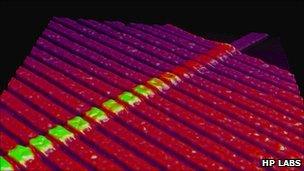Memristor revolution backed by HP
- Published

The devices promise improvements in size, speed and efficiency
Electronics giant HP has joined the world's second-largest memory chip maker Hynix to manufacture a novel member of the electronics family.
The deal will see "memristors" - first demonstrated by HP in 2006 - mass produced for the first time.
Memristors promise significantly greater memory storage requiring less energy and space, and may eventually also be employed in processors.
HP says the first memristors should be widely available in about three years.
The devices started as a theoretical prediction in 1971 but HP's demonstration and publication of a real working device has put them on a possible roadmap to replace memory chips or even hard drives.
They are considered to be the "missing link" in electronics, a fourth element to supplement the more familiar resistor, capacitor and inductor that together form the basis of every electronic device yet made.
In short, it is a resistor with memory: applying an electric voltage can change how much the device blocks electric current - and memristors can "remember" that level - even when the power is turned off.
That makes it a candidate for memory that requires little energy to store information - like the current standard for non-volatile memory, Flash.
"Memristor memory chips promise to run at least 10 times faster and use 10 times less power than an equivalent Flash memory chip," said Stan Williams, the HP Fellow who first demonstrated the memristor, in a statement by the firm.
Memristors can also in principle be used in logic circuits, replacing the actions of the billions of transistors that make up a modern microprocessor - but indications are that will require significant further development.
'Bottom line'
Steve Furber, professor of computer engineering at the University of Manchester, explained that the potential benefits lie in the fact that memristors are "much simpler in principle than transistors".
"Because they are formed as a film between two wires, they don't have to be implanted into the silicon surface - as do transistors, which form the storage locations in Flash - so they could be built in layers in 3D," he told BBC News.
"Of course, the devil is in the detail, and I don't think the manufacturing challenges have been fully exposed yet."
The joint effort between HP and Hynix will aim to develop memristor memory chips known as resistive random access memory (ReRAM), with an aim to have the first products ready by 2013.
Malcolm Penn of the analysts Future Horizons told BBC News that "the combination of HP and Hynix is powerful" but that performance measures such as speed and efficiency were not the only figures of merit.
"It's always hard to displace an incumbent technology, and (the memristor) is chasing a market that's been around a long time," he explained.
"The bottom line is what it costs, and that's always the case with the chip industry. Performance certainly opens doors but people sacrifice performance for cost."